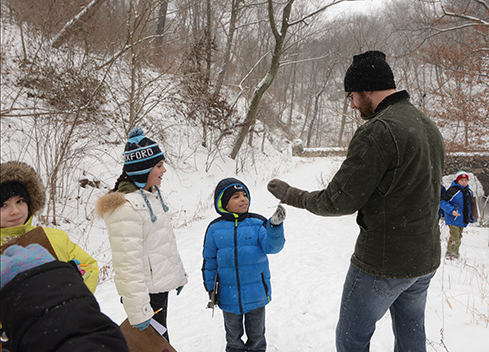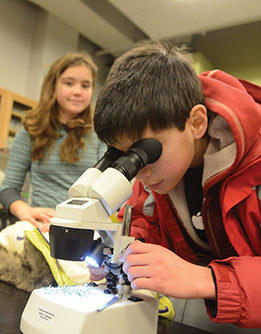 Spring 2014
Spring 2014|
“We want to encourage kids to become naturalists and to care about our environment.”
- Parent and physician Michelina Fato |
Nature as Classroom
A new Saturday program at Carnegie Museum of Natural History harnesses kids’ natural curiosity for something they get too little of these days—nature. On a January day so snowy that most humans were hunkered inside, nine warmly-dressed middle schoolers ventured out the back doors of Carnegie Museum of Natural History, enthusiastically trudging down a trail to neighboring Panther Hollow to look for signs of life.
The wintry weather didn’t faze Dallas Mercurio, a 12-year-old from Shadyside, as she held a meat thermometer to creek water and recorded the reading. “It was cool,” Mercurio says later from the comfort of the museum. “It made me feel like a scientist.” Other participants in the museum’s Youth Naturalist Institute collected leaves, bark, and plants poking out of snow drifts. On this day, the young scientists examine their findings by peering through a compound microscope. “Whoa. It looks like a million craters,” says 10-year-old Noah Sharp of Baldwin, as he peers at a chunk of black birch bark. Brandon Skalniak of Carrick has his own interpretation. “It looks like spider webs.” Like other educational programs at the Museum of Natural History, the institute teaches young people how to do inquirybased science—the kind of investigation museum scientists do every day behind the scenes. Now in its second year, the program, initiated and supported by parents and physicians Michelina Fato and Carl Snyderman, gives youth ages 10 to 13 the opportunity to meet scientists, learn about the museum’s collections, and conduct their own experiments. The couple approached the museum about designing an in-depth experience for middleschoolers like their conservation-minded daughter, Lucia Snyderman, who not only participates but is the founding member of a student leadership board that meets monthly to provide feedback and ideas for future workshops. “We want to encourage kids to become naturalists and to care about our environment,” says Fato. “Our daughter Lucia loves all things having to do with nature, the environment, and animals. We want to help her and other kids her age, especially girls, grow their interest in science and build leadership skills.” All goals that dovetail with the museum’s approach to learning, says Laurie Giarratani, manager of the museum’s school and group programs. “We emphasize fieldwork and what it looks and feels like,” says Giarratani. “Kids like being outdoors, but they don’t always connect it to science. We’re helping them have authentic inquiry and understand what is unique about our museum and our collections.” Each six-week series, held for two hours on Saturdays, focuses on a different theme. These kids are part of the winter series on endangered arctic animals and how they’re influenced by changing climate. Instructors Kristen Tavenor and Justin Collinger began the series by taking the participants on a nature walk to open their eyes to the possibilities of life hidden beneath a winter scape. “A lot of times we go outside and think everything is dead because it’s winter, says Tavenor. “That’s obviously not true. So we looked for evidence of animals.” The young field scientists didn’t find any tracks, but did spot some invasive plant species that stay green all winter, including Asiatic bittersweet, a perennial woody vine.
The instructors also show students how to make scientific observations about habitat, including the temperature of the creek water and land. Mercurio, who hopes to become a marine biologist, recorded higher temperatures for the water than the land, an observation that makes sense to her. “Land cools down and heats up faster than water,” she explains. The nature-loving tween looks forward to her Saturdays at the museum. “It’s like science class,” she says, “but you do fun activities and there are no grades.” Her mother, Tammy Ryan, is happy to find an activity that nurtures her daughter’s interest in natural history. “It’s an amazing program,” she says. “I knew it would be perfect for her. She loves this stuff.” Putting the museum’s collections to good use, Tavenor next asks the students to write their observations about faraway habitats depicted in Polar World: Wyckoff Hall of Arctic Life by comparing two different ecosystems, such as the arctic habitat of a polar bear or walrus and the more temperate habitat of a snake or cheetah. Standing in front of the museum’s walrus diorama, Sharp and Skalniak note that, among other observations, the animal eats clams. “I’m a very curious guy,” offers Sharp when asked what interests him most about the lesson. “I’m interested in a lot of animals. They are just way cool.” Students also examine a collection of real fur pelts. Tavenor asks them to compare and contrast the characteristics of the red fox and arctic fox, two animals with similar body shapes, sizes, and hunting patterns. One student quickly notes that the arctic fox has much smaller ears. “Why would that be?” Tavenor asks. “To keep in heat,” Sharp responds. “Yes, when you go outside, one of the first things that gets cold is your ears,” Tavenor explains. “Ears are a big way to lose heat. The arctic fox has an adaptation of smaller ears.” Like museum scientists, the students will present some of their findings to the museum-going public. For their final project, students will give a brief demonstration on a topic of their choice with the hopes of engaging visitors in a discussion about what they’ve learned. “Kids are very curious about the world around them,” Tavenor says. “They don’t always get an opportunity to go out and physically explore it. We want them to learn how much fun it is, and how much they can learn.”
|
Unraveling Race · Silver & Suede · The Tedious Intrigue of Art Conservation · Sun Struck · President's Note · NewsWorthy · Face Time: Nicholas Chambers · Artistic License: The Science of Sculpture · About Town: Friends of the Forest · The Big Picture
 |
Copyright © 2017 CARNEGIE Magazine. All rights reserved. |


